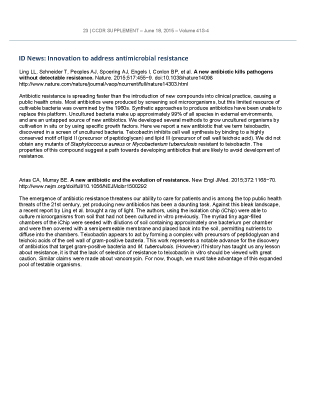ID News: June 2015 (S4)

 Download this article as a PDF (416 KB - 1 page)
Download this article as a PDF (416 KB - 1 page) Published by: The Public Health Agency of Canada
Issue: Volume 41S-4: Antimicrobial stewardship
Date published: June 18, 2015
ISSN: 1481-8531
Submit a manuscript
About CCDR
Browse
Volume 41S-4, June 18, 2015: Antimicrobial stewardship
ID News
Innovation to address antimicrobial resistance
Ling LL, Schneider T, Peoples AJ, Spoering AJ, Engels I, Conlon BP, et al. A new antibiotic kills pathogens without detectable resistance. Nature. 2015;517:455–9. doi:10.1038/nature14098
http://www.nature.com/nature/journal/vaop/ncurrent/full/nature14303.html
Antibiotic resistance is spreading faster than the introduction of new compounds into clinical practice, causing a public health crisis. Most antibiotics were produced by screening soil microorganisms, but this limited resource of cultivable bacteria was overmined by the 1960s. Synthetic approaches to produce antibiotics have been unable to replace this platform. Uncultured bacteria make up approximately 99% of all species in external environments, and are an untapped source of new antibiotics. We developed several methods to grow uncultured organisms by cultivation in situ or by using specific growth factors. Here we report a new antibiotic that we term teixobactin, discovered in a screen of uncultured bacteria. Teixobactin inhibits cell wall synthesis by binding to a highly conserved motif of lipid II (precursor of peptidoglycan) and lipid III (precursor of cell wall teichoic acid). We did not obtain any mutants of Staphylococcus aureus or Mycobacterium tuberculosis resistant to teixobactin. The properties of this compound suggest a path towards developing antibiotics that are likely to avoid development of resistance.
Arias CA, Murray BE. A new antibiotic and the evolution of resistance. New Engl JMed. 2015;372:1168–70.
http://www.nejm.org/doi/full/10.1056/NEJMcibr1500292
The emergence of antibiotic resistance threatens our ability to care for patients and is among the top public health threats of the 21st century, yet producing new antibiotics has been a daunting task. Against this bleak landscape, a recent report by Ling et al. brought a ray of light. The authors, using the isolation chip (iChip) were able to culture microorganisms from soil that had not been cultured in vitro previously. The myriad tiny agar-filled chambers of the iChip were seeded with dilutions of soil containing approximately one bacterium per chamber and were then covered with a semipermeable membrane and placed back into the soil, permitting nutrients to diffuse into the chambers. Teixobactin appears to act by forming a complex with precursors of peptidoglycan and teichoic acids of the cell wall of gram-positive bacteria. This work represents a notable advance for the discovery of antibiotics that target gram-positive bacteria and M. tuberculosis. (However) if history has taught us any lesson about resistance, it is that the lack of selection of resistance to teixobactin in vitro should be viewed with great caution. Similar claims were made about vancomycin. For now, though, we must take advantage of this expanded pool of testable organisms.
Page details
- Date modified: